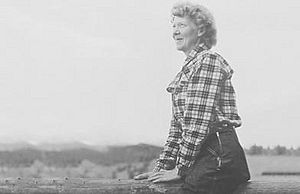Hazel Schmoll facts for kids
Quick facts for kids
Hazel Schmoll
|
|
|---|---|
 |
|
| Born |
Hazel Marguerite Schmoll
August 23, 1890 |
| Died | January 31, 1990 (aged 99) |
| Nationality | American |
| Alma mater | University of Colorado University of Chicago |
| Scientific career | |
| Fields | Botany |
| Author abbrev. (botany) | Schmoll |
Hazel Marguerite Schmoll (1890–1990) was an amazing American botanist. She was the first person to carefully study all the plants in southwestern Colorado. She also made history as the first woman to get a special advanced degree (a doctorate) in botany from the University of Chicago. In 1985, she was honored by being added to the Colorado Women's Hall of Fame.
Contents
Growing Up and Learning: Hazel's Early Life
Hazel Marguerite Schmoll was born in a simple sod cabin. This was in McAllaster, Kansas, on August 23, 1890. Her parents were William and Amelia Schmoll. When she was two, her family moved to Ward, Colorado. There, her father opened a stable for horses called a livery stable.
Hazel loved learning about wildflowers from a young age. She spent a lot of time riding horses around the area. She would collect plant samples and pick berries. She always said her childhood in Ward was perfect. She kept a strong connection to the town her whole life.
School Days and College
Hazel went to Ward School until eighth grade. After that, she attended the State Preparatory School in Boulder. This school later became Boulder High School. She then went to the University of Colorado. In 1913, she graduated with a degree in biology.
For four years (1913–1917), she taught at Vassar College. She first worked in the biology department. Later, she moved to the botany department. She was the first graduate from the University of Colorado to be hired by Vassar. Colorado was the first state to let women vote. Because of this, Hazel actively supported women's suffrage (the right for women to vote) on campus.
Hazel realized she needed a higher degree to keep teaching at Vassar. So, she enrolled at the University of Chicago. She wanted to get a master's degree in botany. She mainly studied with a famous botanist named Henry Chandler Cowles. He was a pioneer in studying how plants live in their environment. She earned her master's degree in 1919.
Hazel's Work as a Botanist
After getting her master's degree, Hazel returned to Colorado. She was hired by the Colorado Historical and Natural History Society. She worked at the Colorado State Museum. Her first job was to organize and label plant collections. These collections belonged to Alice Eastwood and Ellsworth Bethel. The plant collection she helped create is still one of the best in the state.
Hazel then started the first organized study of plants in southwestern Colorado. This big project later became part of her special paper for her doctorate degree. Another important part of her job was to teach people about plants in the Rocky Mountains. For a short time (1920–1921), she was an assistant curator for the State Bureau of Mines.
In 1925, she was a main leader in trying to pass a law. This law would protect Colorado's state flower, the blue columbine (Aquilegia coerulea). Hazel thought her job would be short-term. But it lasted until 1925, when she left to get her doctorate.
Earning Her Doctorate
In late 1925, Hazel traveled to Europe. She visited many botanical gardens and learned German. When she came back, she enrolled at the University of Chicago again. She wanted to get a Ph.D. (doctorate) in ecological botany. She supported herself by doing various jobs. These included cleaning houses and rewriting a high school biology textbook. She also worked at the Field Museum of Natural History. She even filled in as a professor at a local college.
In 1932, she made history again. She became the first woman to get a Ph.D. in botany from the University of Chicago. Her special paper was about the plants in the Chimney Rock area of southwestern Colorado.
Ranch Life and Later Years
During the Great Depression, it was hard for scientists to find steady jobs. In 1938, Hazel built Rangeview Ranch near Ward. At first, it was a camp for children. Later, it became a guest ranch. It was right next to Rocky Mountain National Park. Hazel worked as a nature guide for her guests even into her seventies. She spent her summers at the ranch and the rest of the year in a house in Ward.
Hazel Schmoll passed away on January 31, 1990, at 99 years old. Much of her land was given away to help protect nature. Rangeview Ranch was given to the Christian Science Church. They used it as a place for quiet reflection and meetings. In 2017, the ranch was sold again. It is now the Rocky Mountain Ecodharma Retreat Center.
Hazel's Lasting Impact
To honor Hazel Schmoll, the University of Colorado, Boulder, created a special award. It is called the Hazel Schmoll Research Fellowship in Colorado Botany. This award helps faculty, staff, and students study plants in the field.
A rare type of plant, a milkvetch (also called locoweed), is named after Hazel. It is called Astragalus schmolliae or Schmoll's milkvetch. This plant only grows on Chapin Mesa in Mesa Verde National Park. Alice Eastwood first collected it there in 1890. Hazel and her assistant found it again in 1925. The plant was not officially described until 1945. That's when it was named after Schmoll.
Hazel Schmoll kept many detailed notebooks. These important records are now kept in the archives of the Boulder Historical Society.
See also
 In Spanish: Hazel Marguerite Schmoll para niños
In Spanish: Hazel Marguerite Schmoll para niños

